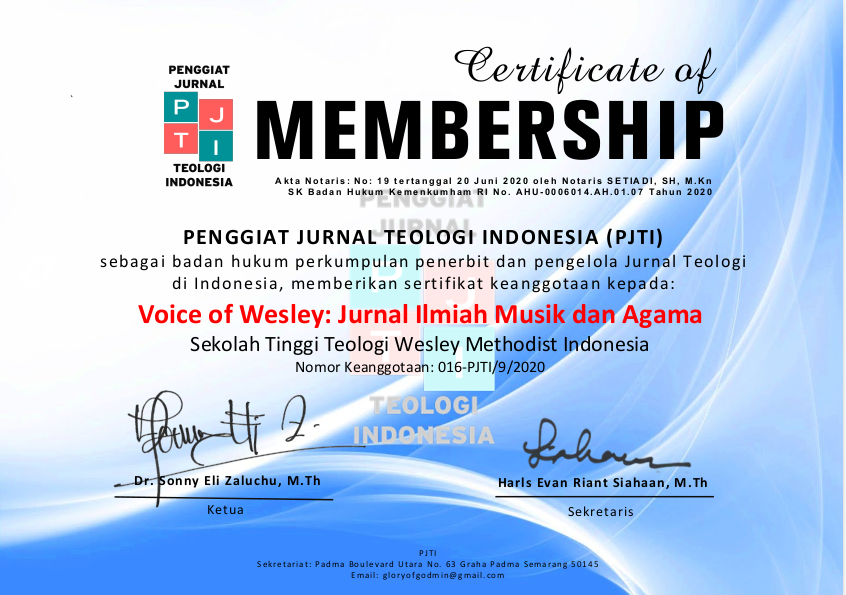PENGGUNAAN INSTRUMEN DRUM DI DALAM IBADAH: KAJIAN KATA TSLATSAL DAN TOPH DALAM MAZMUR 150
Abstract
ABSTRACT
Drums as one of instruments in a band often bring conflict in relation to its use in Sunday service. Some mainstream churches have already accepted the use of drums in their Sunday service, but some still refused the use of that instrument, because drums are usually identified with bad music genre, such as rock, jazz and other genres that show rebellion and sinful life. This article aims to study two instruments in Psalms 150 that are known as drums throughout Israel’s history, which are toph and tslatsal. This study shows that drums were used by Israeli and also ancient Near East people as part of their life, especially to praise and worship God every day, as written in Psalms. I used qualitative method of literature study to uncover data about the two instruments from the Bible using native language of Hebrew, English, and Indonesian, traditional Jewish notes, church fathers’ commentary in early Christianity, and also a few journals that have examined the study of the use of drums in the past and also modern. I show that eventhough early church fathers had refused the use of drums in early Christianity, but no Jewish tradition opposed the use of drums to worship God. For Psalms writer, drums are tools or expressions of praise to God. I argue that churches need to realize drums as one of media that God allows to evolve to be used to worship God, especially in Sunday service.
Keywords: Psalms, toph, tslatsal, drums, service.
Â
ABSTRAKÂ Â Â Â
Alat musik drum sebagai salah satu instrumen di dalam sebuah band seringkali mendatangkan pertentangan sehubungan dengan penggunaannya di dalam ibadah. Beberapa gereja mainstream memang sudah menerima penggunaan drum di dalam ibadah umumnya, tetapi sebagian lagi masih menolak instrumen tersebut, karena drum diidentikan dengan beberapa genre musik yang buruk, seperti rock, jazz, dan genre lain yang menunjukkan pemberontakan dan kehidupan dosa lainnya. Artikel ini bertujuan untuk mengkaji dua instrumen di dalam Mazmur 150 yang dikenal sebagai alat musik drum di sepanjang sejarah Israel, yaitu toph dan tslatsal. Kajian ini menunjukkan bahwa instrument drum tersebut digunakan oleh orang Israel dan juga Timur Dekat Kuno sebagai bagian kehidupan, terutama untuk beribadah dan memuji Tuhan sehari-hari, seperti yang tertulis di dalam kitab Mazmur. Peneliti menggunakan metode kualitatif studi pustaka untuk menggali data mengenai dua instrumen tersebut dari Alkitab dengan bahasa asli Ibrani, Inggris, dan Indonesia, catatan-catatan tradisi Yahudi, catatan tafsiran dari bapa-bapa gereja di awal-awal kekristenan, dan juga berbagai artikel jurnal yang telah membahas kajian penggunaan instrument drum di masa lampau dan juga modern. Peneliti menunjukkan bahwa sekalipun bapa-bapa gereja awal sempat menolak penggunaan drum di awal-awal kekristenan, tetapi tidak ditemukan tradisi Yahudi yang mempersoalkan penggunaannya untuk memuji Allah. Bagi penulis Mazmur, drum merupakan alat atau ekspresi dari pujian kepada Allah. Peneliti berargumen bahwa gereja perlu menyadari bahwa drum merupakan salah satu media yang Allah izinkan berkembang untuk dapat digunakan memuji Tuhan, terutama di dalam ibadah.
Kata Kunci: Mazmur 150, toph, tslatsal, drum, ibadah.
Keywords
Full Text:
PDFReferences
Aipassa, Nicholas Gustav Francois. “Paham John Calvin Mengenai Musik dan Perkembangan Musik dalam Ibadah GPIB Marga Mulya Yogyakarta.†Skripsi Duta Wacana, 2017.
Augustine, Confessions. Terj. Henry Chadwick. Oxford: Oxford University Press, 1991.
________. Exposition on the Book of Psalms. Terj. John Henry Parker. London: Monergism, 1847.
________. On Christian Teaching. Terj. R.P.H. Green. Oxford: Oxford University Press, 2008.
Friedman, Jonathan L. Music in Biblical Life: The Role of Song in Ancient Israel. North Carolina: McFarland & Company, Inc., Publishers, 2013.
Frith, Simon. “Rock Music,†http://www.britannica.com/art/rock-music/Crucial-rock-musicians.
Handoko, Yakub Tri. “Mengapa Gaya Ibadah Di GKRI Exodus Kontemporer?†https://rec.or.id/mengapa-gaya-ibadah-di-gkri-exodus-kontemporer/
Human, Dirk J. “Praise beyond Words’: Psalm 150 as grand finale of the crescendo in the Psalter,†HTS: Theological Studies (2011): 1-10.
Jacobson, Joshua. “Decoding the Secrets of the Psalms,†Choral Journal 56, no. 7.
Josephus, Antiquities of the Jews, VII:12:3, https://penelope.uchicago.edu/josephus/ant-7.html.
McKinnon, James William. “The Church Fathers and Musical Instruments†(Disertasi dari Columbia University, 1967).
_________. “Musical Instruments in Medieval Psalm Commentaries and Psalters,†Journal of the American Musicological Society, 21, no. 1 (Spring, 1968): 3- 20.
Mauricio Molina, “In Tympano Rex Noster Tympanizavitâ€: Frame Drums As Messianic Symbols In Medieval Spanish Representations Of The Twenty-Four Elders Of The Apocalypse,†Music in Art XXXII/1–2 (2007): 93-101.
_________. “Tympanum tuum Cybele : Pagan Use and Christian Transformation of a Cultic Greco-Roman Percussion Instrument,†Moysiké= Musica en el món antic i el món antic en la música (2014): 51-69.
Oosthuizen, Rudolph De Wet. “The drum and its significance for the interpretation of the Old Testament from an African perspective: Part two,†Verbum et Ecclesia 37, 1 (2016): 1-9.
S.J., Michael C. Mccarthy. “An Ecclesiology Of Groaning: Augustine, The Psalms, And The Making Of Church,†Theological Studies 66 (2005): 23-48.
Smith, John Arthur. Music in Ancient Judaism and Early. Farnham: Ashgate Publishing Limited, 2011.
Stainer, John. The Music of the Bible: With Some Account Of The Development Of Modern Musical Instruments From Ancient Types. New York: Da Capo Press, 1970.
Young, Anathea Portier. “Tongues and Cymbals: Contextualizing 1 Corinthians 13:1,†Biblical Theology Bulletin (2005): 1-7.
https://www.sefaria.org/Arakhin.10b.11?ven=William_Davidson_Edition_ _English&vhe=Wikisource_Talmud_Bavli〈=bi (diakses 18 April 2022).
https://bible.usccb.org/bible/judith/16 (diakses 18 April 2022).
DOI: https://dx.doi.org/10.36972/jvow.v6i1.164 Abstract view : 442 times | PDF view : 359 times
Refbacks
- There are currently no refbacks.
Copyright (c) 2022 Voice of Wesley: Jurnal Ilmiah Musik dan Agama

Jurnal Voice Of Wesley by Sekolah Tinggi Teologi Wesley Methodist Indonesia is licensed under a Creative Commons Attribution-ShareAlike 4.0 International License. Alamat Penerbit: Jl. Bandengan Utara No. 31BA RT/RW. 07/11, Kel Pekojan Kec. Tambora Kota Administrasi Jakarta Barat Kode Pos 11240.
No. Telepon : 021-22695566 ; Fax. 021-22695566






